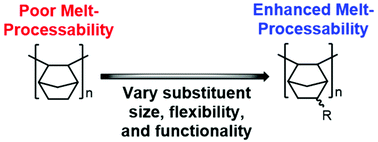Design, synthesis, and characterization of vinyl-addition polynorbornenes with tunable thermal properties†
Abstract
Unfunctionalized vinyl-addition polynorbornene (VAPNB) possesses many outstanding properties such as high thermal, chemical, and oxidative stability. These features make VAPNB a promising candidate for many engineering applications. However, VAPNB has a small service window between its glass transition temperature (Tg) and decomposition temperature (Td), and it cannot be readily processed in a melt state. In this work, we demonstrate that the service window of VAPNBs can be tailored through the use of norbornene monomers bearing alkyl, aryl, and aryl ether substituents. The vinyl addition homopolymerization and copolymerization of these functionalized norbornyl-based monomers yielded VAPNBs with high T′gs (>150 °C) and large service windows (Td–Tg > 100 °C), which are comparable to other commercial engineering thermoplastics. To further establish the feasibility of melt processing, a functionalized VAPNB material with Tg = 209 °C and a service window of 170 °C was successfully extruded and molded into bars. Subsequent characterization of the bars by dynamic mechanical analysis (DMA), nuclear magnetic resonance spectroscopy (NMR), and gel permeation chromatography (GPC) revealed only minor signs of polymer degradation. These studies suggest that substituted VAPNBs could be developed into a new class of engineering thermoplastics that is compatible with workhorse melt processing techniques such as extrusion and injection molding, as well as emerging techniques such as extrusion-based 3D printing.



 Please wait while we load your content...
Please wait while we load your content...